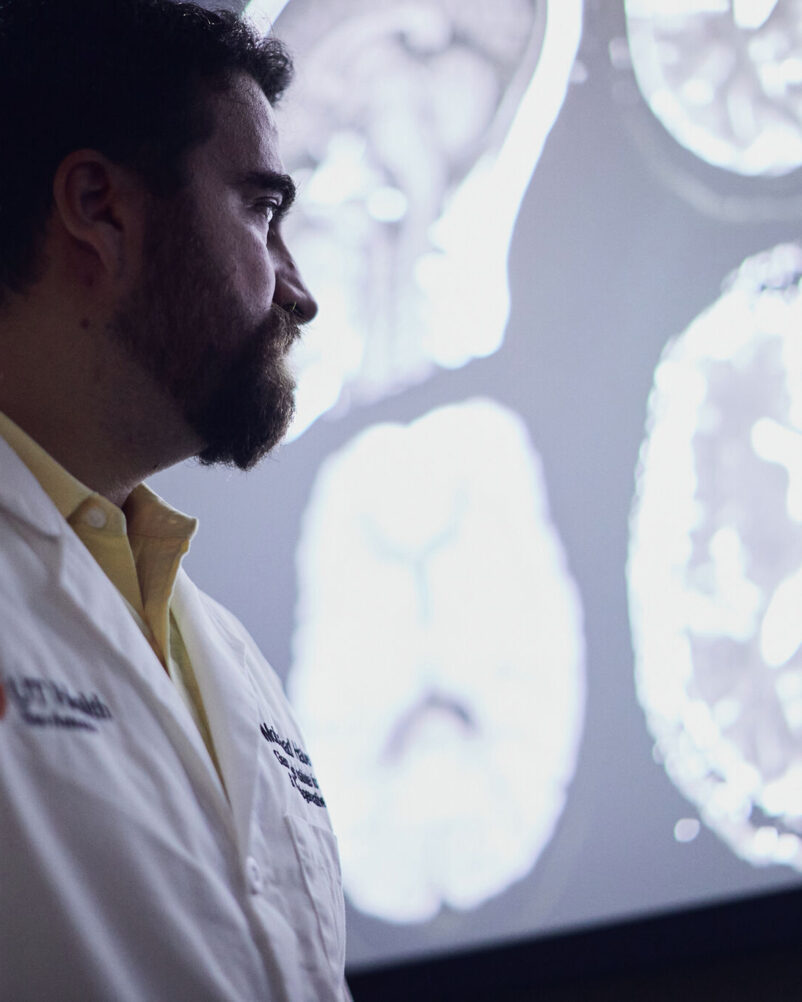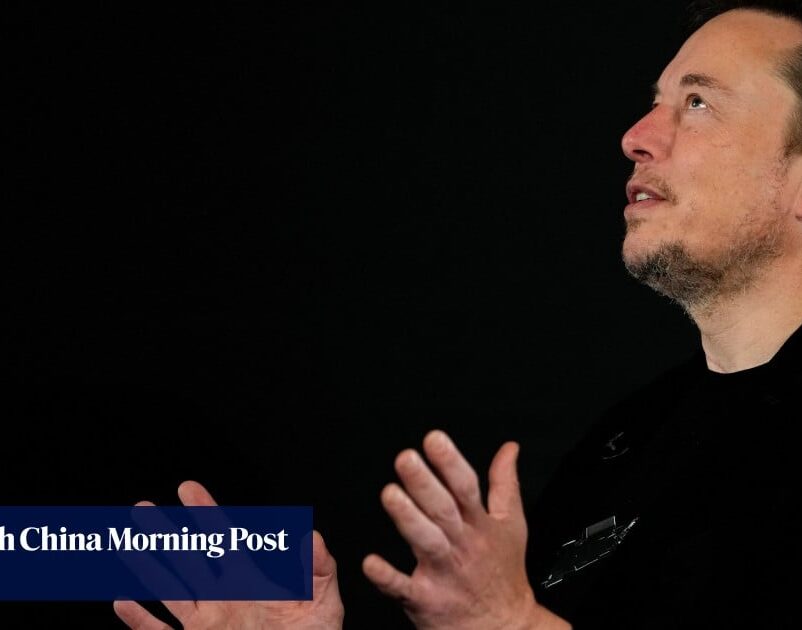
Mohamed Habes spends a lot of time looking at brain scans, hunting for signs of disease that can lead to stroke and dementia.
It’s a big job. The telltale signs the UT Health San Antonio researcher is looking for could be hiding among 500 or more similar small spaces on the MRI of a middle-aged person’s brain.
“Think about a neuroradiologist who is going to sit down and count all of them,” said Habes, a director at the health center’s Glenn Biggs Institute for Alzheimer’s and Neurodegenerative Diseases. “That’s not really going to happen. He or she would spend one or two hours per scan, or even more, and that amount of laborious effort is not feasible in the workflow of a busy clinic.”
To speed diagnoses, he’s developed an artificial intelligence-powered device that counts the lesions in seconds.
Such symptoms, Habes said, are “tremendously difficult to quantify without AI.”
RELATED: UT Health San Antonio helps pioneer use of AI-enabled diabetes control
His work is just one example of the accelerating use of artificial intelligence in San Antonio health care as academic institutions, nonprofits and private medical facilities step up investments in technology that can aid in tasks ranging from humdrum digital paperwork to diagnosis.
Leaders at major medical institutions say they support the rise of AI as a medical sidekick but emphasize that humans are still needed to double-check the technology’s ability to accurately produce notes into electronic medical records, scan medical images, and aid in diagnosing and treating patients.
Among the efforts at University Health System is a pilot program to use AI voice recognition to transcribe patient notes in electronic health records, said Bill Phillips, senior vice president and chief information officer.
Human factor
The health system is also beginning to use AI chatbots to process data such as billing information, he said. It’s considering other types of AI, too, including some that connects calls to patient rooms, and allows patients to make appointments and contact their physicians.
“We don’t see it affecting any jobs,” he said of the possibility that increasing use of AI could lead to workforce reductions. “We see it processing a large workload at a faster rate.”
The AI-embedded electronic health records help researchers and physicians “predict if a patient is going to end up being admitted based on symptoms and results,” Phillips said. However, human staff and physicians are expected to double-check the AI and make final decisions.
“This is where a physician and a patient just have a conversation and the AI is capturing the key elements and doing the charting for the provider,” he said. “AI will always have a human factor, so the provider’s job will be to review what the AI system documented and make sure it’s accurate.”
At Methodist Healthcare System, physicians have been using AI to detect blockages of brain arteries that can result in strokes. They also use the technology to detect pulmonary embolisms, a potentially fatal condition.
RELATED: Rackspace launches initiative to train thousands of employees on artificial intelligence
“AI in health care is an indispensable capability to quickly help identify potential life-threatening health conditions,” said Eddie Cuellar, the health system’s longtime chief information officer. “Methodist Healthcare uses several health care AI imaging capabilities to provide the highest quality patient care.”
Earlier this year, Baptist Health System in San Antonio announced it was using AI technology to help speed up scans by 40 percent, with the most common imaging of spine and joints being performed in roughly 12 minutes. The Baptist M&S Orthopedic and Neurologic Imaging Institute on Loop 1604 said it was the first location in the country to use the technology.
Dr. Carlos Morales, a radiologist at Baptist, said the AI tool uses deep learning methods trained on large batches of related data to make MRI images. Such scans require patients to remain as still as possible during the scanning process. Movement can result in blurry images — the enemy of radiologists everywhere. But the AI tool is fast, so it limits the impact of movement and makes clearer images.
“The technology is a game changer,” he said.
At UT Health’s Long School of Medicine, Dr. Rajeev Suri participated in a study last year to collect data from 60 radiologists as they read X-rays at University Hospital. He hoped feeding large amount of data into the AI would train the software to mimic human reading patterns to provide a machine version of a second opinion.
UT Health’s latest AI tool, which identifies brain lesions, is not in clinical practice yet. But Habes plans to begin applying it to patient data next year to aid diagnostics.
“It will make life much easier for neuroradiologists,” he said. “It will make a diagnosis. But the final word is for the radiologists and the doctors.”
Beyond in-hospital efforts, medical professionals are also prescribing AI-powered medical devices. Local physicians have begun use of an AI-enabled device that regulates blood sugar levels of young people with Type 1 diabetes.
Dr. Jane Lynch, professor of pediatric endocrinology and diabetes at UT Health San Antonio who treats children at University Health’s Texas Diabetes Institute, is among the first physicians to deliver the device to young people in Central and South Texas.
‘Dizzying pace’
Despite their optimism about an AI-fueled medical future, researchers and physicians say it comes at a time of regulatory uncertainty and they expect a mix of reactions from patients who might express safety and privacy concerns. All agreed any use of AI must keep humans in the loop.
Morales, of Baptist Health, said the AI tools are continually improving but “it’s not rare” that the technology marks an artery blockage in a medical image before he realizes it’s just a blood vessel.
“I don’t see a time when patients or other physicians are going to be 100 percent happy with what’s coming out of the machine without a human saying, ‘This is absolutely correct,’” he said. “But this can help me be a lot more efficient in looking at these scans. It can help me look at things a little bit faster at this point. I can imagine what it would be like 10 years or 20 years.”
RELATED: Using AI to help San Antonio radiologists reduce X-ray reading errors
Dr. Bryan Alsip, executive vice president and chief medical officer at University Health, stressed the importance of adopting “validated” technology when reviewing electronic medical records that can impact a patient’s history, lab results, diagnosis, prescriptions and billings amid the “dizzying pace of AI use in the health industry.”
“I still want that human individual to make that final decision in conversation with patients rather than leave that to a machine to make the final decisions,” he said. “It’s just an evolution of what we have, but it’s probably a more informed decision making those recommendations, which is why we need to be diligent.”
University Health has yet to use AI technology to scan medical images. But it’s considering how the technology could be helpful in radiology, predictive analysis and virtual nursing.
“All those things are coming, but you have to be very cautious,” said Phillips, the University Health CIO, as he noted the pros and cons with new technologies — including cybersecurity risks. “We’re going after it, but we’re doing it at a manageable pace.”
AI investments
The work in health care comes as other industry segments in San Antonio are embracing or unavoidably being introduced to AI technology.
The San Antonio Police Department has been flying drones using AI to observe large crowds, analyze traffic collisions and for tactical operations. Rackspace Technology Inc., the city’s largest technology company, is training its employees on AI tools.
Local real estate professionals are using ChatGPT, the popular AI-based chatbot, to write listing descriptions for homes and draft financing terms for deals. The Southwest Research Institute nonprofit developed an AI markless motion capture system, a tool that can help pitchers throw faster without injuring themselves, as well as aid medical clinics looking to detect diseases and conditions, such as dementia, based on how a person walks.
RELATED: SwRI develops AI-powered tool to bring motion-capture analysis out of lab and into the field
Medical professionals say adoption of AI must be cost-effective. Since AI research can be costly and time-consuming, UT Health researcher Habes said he’s seeking funding from the National Institutes of Health to develop algorithms and train them on data. But the city’s health institutions are pouring money into recruiting AI experts as health systems in San Antonio, Austin, Dallas and Houston are racing to build their technology.
UT Health spokesman Will Sansom said the health system is recruiting “in core strengths with promising new research directions, including AI.” He named Habes, a Ph.D. former adjunct assistant professor at the Perelman School of Medicine at the University of Pennsylvania, as a “prime example” of the health system “bringing in faculty who have deep-learning expertise.”
The city’s medical centers declined to disclose the exact amounts their institutions were investing in AI technologies.
Asked how much UT Health San Antonio has invested into AI research and technologies, Sansom said, “It is not feasible currently to provide an estimate of the time (resources) spent on the research, exploration, development, integration or execution of AI.”
The health system has an annual research portfolio of $360 million, he added, and is “rapidly trending” toward $400 million.
Sansom noted that the Greehey Children’s Cancer Research Institute and the Glenn Biggs Institute for Alzheimer’s and Neurodegenerative Diseases, both at UT Health San Antonio, have together spent nearly $1 million on a supercomputer that can train AI tools on deep-learning models.
The so-called Genie supercomputer can be used to develop the new AI tool to better count brain lesions on MRI scans. It’s equipped with “graphical processing units, which are very important components to developing deep-learning models,” Sansom said. “Those GPUs made it possible to develop and train the AI tool for detecting and counting brain lesions.”
UT Health San Antonio also said it expects the Genie will be studied at the Alzheimer’s Disease Research Centers, which are U.S. National Institute on Aging-Designated Centers of Excellence. The South Texas ADRC, the only one of its kind in Texas, is a collaboration of UT Health’s Biggs Institute with the University of Texas Rio Grande Valley.
The idea of using AI in Alzheimer’s-related research comes as UT Health San Antonio in May began construction on its $100 million patient care and clinical trials facility called the Center for Brain Health. The center is expected to be completed in 2025.



